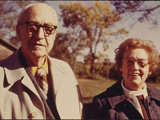|
|
TODAY.AZ / Weird / Interesting
Do old married couples look alike?
12 November 2011 [13:16] - TODAY.AZ
 As long as you aren’t related, marrying someone who looks similar to you is advantageous, says Philippe Rushton, a psychologist at the University of Western Ontario. We use physical likeness as a way to assess underlying genetic likeness, which can cause us to be subconsciously attracted to reflections of ourselves. In evolutionary biology, the phenomenon is called “assortative mating,” or “self seeking like.” By mating with people who are genetically similar, you ensure that “your own segment of the gene pool is safely maintained and transmitted to future generations.”
As long as you aren’t related, marrying someone who looks similar to you is advantageous, says Philippe Rushton, a psychologist at the University of Western Ontario. We use physical likeness as a way to assess underlying genetic likeness, which can cause us to be subconsciously attracted to reflections of ourselves. In evolutionary biology, the phenomenon is called “assortative mating,” or “self seeking like.” By mating with people who are genetically similar, you ensure that “your own segment of the gene pool is safely maintained and transmitted to future generations.”Rushton and his colleagues have shown that the more heritable the physical characteristics, the higher the chance of mating between individuals with those particular traits. Height and wrist circumference, for example, are far more inheritable than waist size. “If you look at spouses across these characteristics, they are the most similar on the more genetic components,” Rushton says.
Robert Zajonc, a psychologist, found that physical likeness between couples increases over time. Through the years, couples’ wrinkles form in the same places because of a lifetime of shared emotions, he wrote in the journal Motivation and Emotion. Rushton hypothesizes instead that lookalike seniors have always looked similar and that it just becomes more obvious as they get older. As you grow old, “lots of distinguishing features drop away, like flesh on the skin or hair on the head,” Rushton says. “It’s more the bony structure of the skeleton that’s showing through.”
But what about people and their pets? Psychologist Michael Roy of Elizabethtown College studies whether or not dogs and their owners resemble each other. He has found that, indeed, purebreds do tend to mirror their owners, but not mutts. “Let’s say you’re very outgoing,” Roy says. “You would choose a dog that is likely to run up to other people, too.”
/Popular Science/
URL: http://www.today.az/news/interesting/98071.html
 Print version
Print version
Views: 2303
Connect with us. Get latest news and updates.
See Also
- 05 February 2025 [19:41]
Japan plans to negotiate with Trump to increase LNG imports from United States - 23 January 2025 [23:20]
Dubai once again named cleanest city in the world - 06 December 2024 [22:20]
Are scented candles harmful to health? - 23 November 2024 [14:11]
Magnitude 4.5 earthquake hits Azerbaijan's Lachin - 20 November 2024 [23:30]
Launch vehicle with prototype of Starship made its sixth test flight - 27 October 2024 [09:00]
Fuel prices expected to rise in Sweden - 24 October 2024 [19:14]
Turkiye strikes terror targets in Iraq and Syria - 23 October 2024 [23:46]
Kazakhstan supplied almost entire volume of oil planned for 2024 to Germany in 9 months - 23 October 2024 [22:17]
Taiwan reported passage of Chinese Navy aircraft carrier near island - 23 October 2024 [21:50]
Russia remains largest oil supplier to India
Most Popular
 Pashinyan signed up for a ChatGPT course
Pashinyan signed up for a ChatGPT course
 Mono-Armenia what tales did Pashinyan tell in Washington
Mono-Armenia what tales did Pashinyan tell in Washington
 Turkiye’s President Erdo?an approves migration cooperation agreement with Azerbaijan
Turkiye’s President Erdo?an approves migration cooperation agreement with Azerbaijan
 Ruins of an Azerbaijani mosque are being desecrated in Yerevan
Ruins of an Azerbaijani mosque are being desecrated in Yerevan
 Azerbaijan bans entry of Russian MP over offensive remarks
Azerbaijan bans entry of Russian MP over offensive remarks
 Armenians are preparing for a "crusade" against Baku – hopes for the United States
Armenians are preparing for a "crusade" against Baku – hopes for the United States
 Azerbaijan’s fire safety service reviews 2024 successes and prepares for 2025
Azerbaijan’s fire safety service reviews 2024 successes and prepares for 2025
